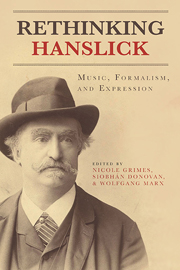Book contents
- Frontmatter
- Contents
- Foreword by Mark Evan Bonds
- Acknowledgments
- Abbreviations
- Chronology
- Introduction
- Part One Rules of Engagement
- Part Two Liberalism and Societal Order
- 5 Hanslick on Johann Strauss Jr.: Genre, Social Class, and Liberalism in Vienna
- 6 Waltzing around the Musically Beautiful: Listening and Dancing in Hanslick's Hierarchy of Musical Perception
- 7 “Poison-Flaming Flowers from the Orient and Nightingales from Bayreuth”: On Hanslick's Reception of the Music of Goldmark
- 8 German Humanism, Liberalism, and Elegy in Hanslick's Writings on Brahms
- Part Three Memoirs and Meaning in Social Contexts
- Part Four Critical Battlefields
- Selected Bibliography
- List of Contributors
- Index
8 - German Humanism, Liberalism, and Elegy in Hanslick's Writings on Brahms
from Part Two - Liberalism and Societal Order
Published online by Cambridge University Press: 05 July 2013
- Frontmatter
- Contents
- Foreword by Mark Evan Bonds
- Acknowledgments
- Abbreviations
- Chronology
- Introduction
- Part One Rules of Engagement
- Part Two Liberalism and Societal Order
- 5 Hanslick on Johann Strauss Jr.: Genre, Social Class, and Liberalism in Vienna
- 6 Waltzing around the Musically Beautiful: Listening and Dancing in Hanslick's Hierarchy of Musical Perception
- 7 “Poison-Flaming Flowers from the Orient and Nightingales from Bayreuth”: On Hanslick's Reception of the Music of Goldmark
- 8 German Humanism, Liberalism, and Elegy in Hanslick's Writings on Brahms
- Part Three Memoirs and Meaning in Social Contexts
- Part Four Critical Battlefields
- Selected Bibliography
- List of Contributors
- Index
Summary
I could almost envy [Hanslick] his power of expressing himself, if not exhaustively, yet with an intuitive sympathy, which not only provides an outlet for his own feelings but helps others who have no command of words to express theirs.
—Elisabet von Herzogenberg to Brahms, January 3, 1882Eduard Hanslick's reviews of the works of Johannes Brahms span from 1862, when he announced “the appearance before the Viennese public of this blond, St. John visage of a composer,” to the year of Hanslick's death, 1904. Composer and critic struck up a close and lifelong friendship following their meeting in 1862, a friendship they shared with the Austrian surgeon and amateur musician Theodor Billroth—the three being on intimate du terms and forming the “closest musical threesome.” Hanslick was the music correspondent for the Neue Freie Presse, Austria's leading liberal daily newspaper. It was here that he published his abundant and multifarious writings on Brahms. Not only are Hanslick's Brahms reviews musically perceptive and insightful, they can also be understood as a cultural commentary on the musical world of Vienna in the late nineteenth century, and they illuminate the cultural, religious, and political context in which Brahms's works were composed and received.
- Type
- Chapter
- Information
- Rethinking HanslickMusic, Formalism, and Expression, pp. 160 - 184Publisher: Boydell & BrewerPrint publication year: 2013

